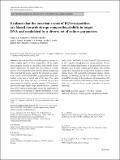| dc.contributor.author | Gonçalves, Geisa A. L. | |
| dc.contributor.author | Oliveira, Pedro H. | |
| dc.contributor.author | Gomes, Ana G. | |
| dc.contributor.author | Lewis, Leslie A. | |
| dc.contributor.author | Monteiro, Gabriel A. | |
| dc.contributor.author | Jones, Kristala L. | |
| dc.contributor.author | Prazeres, Duarte Miguel | |
| dc.date.accessioned | 2016-09-22T21:24:20Z | |
| dc.date.available | 2016-09-22T21:24:20Z | |
| dc.date.issued | 2014-04 | |
| dc.date.submitted | 2014-03 | |
| dc.identifier.issn | 0175-7598 | |
| dc.identifier.issn | 1432-0614 | |
| dc.identifier.uri | http://hdl.handle.net/1721.1/104375 | |
| dc.description.abstract | Insertion specificity of mobile genetic elements is a rather complex aspect of DNA transposition, which, despite much progress towards its elucidation, still remains incompletely understood. We report here the results of a meta-analysis of IS2 target sites from genomic, phage, and plasmid DNA and find that newly acquired IS2 elements are consistently inserted around abrupt DNA compositional shifts, particularly in the form of switch sites of GC skew. The results presented in this study not only corroborate our previous observations that both the insertion sequence (IS) minicircle junction and target region adopt intrinsically bent conformations in IS2, but most interestingly, extend this requirement to other families of IS elements. Using this information, we were able to pinpoint regions with high propensity for transposition and to predict and detect, de novo, a novel IS2 insertion event in the 3′ region of the gfp gene of a reporter plasmid. We also found that during amplification of this plasmid, process parameters such as scale, culture growth phase, and medium composition exacerbate IS2 transposition, leading to contamination levels with potentially detrimental clinical effects. Overall, our findings provide new insights into the role of target DNA structure in the mechanism of transposition of IS elements and extend our understanding of how culture conditions are a relevant factor in the induction of genetic instability. | en_US |
| dc.description.sponsorship | Fundação para a Ciência e a Tecnologia (PTDC/EBB-EBI/113650/2009) | en_US |
| dc.description.sponsorship | MIT-Portugal Program | en_US |
| dc.publisher | Springer Berlin Heidelberg | en_US |
| dc.relation.isversionof | http://dx.doi.org/10.1007/s00253-014-5695-6 | en_US |
| dc.rights | Creative Commons Attribution-Noncommercial-Share Alike | en_US |
| dc.rights.uri | http://creativecommons.org/licenses/by-nc-sa/4.0/ | en_US |
| dc.source | Springer Berlin Heidelberg | en_US |
| dc.title | Evidence that the insertion events of IS2 transposition are biased towards abrupt compositional shifts in target DNA and modulated by a diverse set of culture parameters | en_US |
| dc.type | Article | en_US |
| dc.identifier.citation | Gonçalves, Geisa A. L. et al. “Evidence That the Insertion Events of IS2 Transposition Are Biased towards Abrupt Compositional Shifts in Target DNA and Modulated by a Diverse Set of Culture Parameters.” Applied Microbiology and Biotechnology 98.15 (2014): 6609–6619. | en_US |
| dc.contributor.department | MIT-Portugal Program | en_US |
| dc.contributor.department | Massachusetts Institute of Technology. Department of Chemical Engineering | en_US |
| dc.contributor.mitauthor | Monteiro, Gabriel A. | |
| dc.contributor.mitauthor | Jones, Kristala L. | |
| dc.contributor.mitauthor | Prazeres, Duarte Miguel | |
| dc.relation.journal | Applied Microbiology and Biotechnology | en_US |
| dc.eprint.version | Author's final manuscript | en_US |
| dc.type.uri | http://purl.org/eprint/type/JournalArticle | en_US |
| eprint.status | http://purl.org/eprint/status/PeerReviewed | en_US |
| dc.date.updated | 2016-08-18T15:24:29Z | |
| dc.language.rfc3066 | en | |
| dc.rights.holder | Springer-Verlag Berlin Heidelberg | |
| dspace.orderedauthors | Gonçalves, Geisa A. L.; Oliveira, Pedro H.; Gomes, Ana G.; Prather, Kristala L. J.; Lewis, Leslie A.; Prazeres, Duarte M. F.; Monteiro, Gabriel A. | en_US |
| dspace.embargo.terms | N | en |
| dc.identifier.orcid | https://orcid.org/0000-0003-0437-3157 | |
| mit.license | OPEN_ACCESS_POLICY | en_US |
| mit.metadata.status | Complete | |
